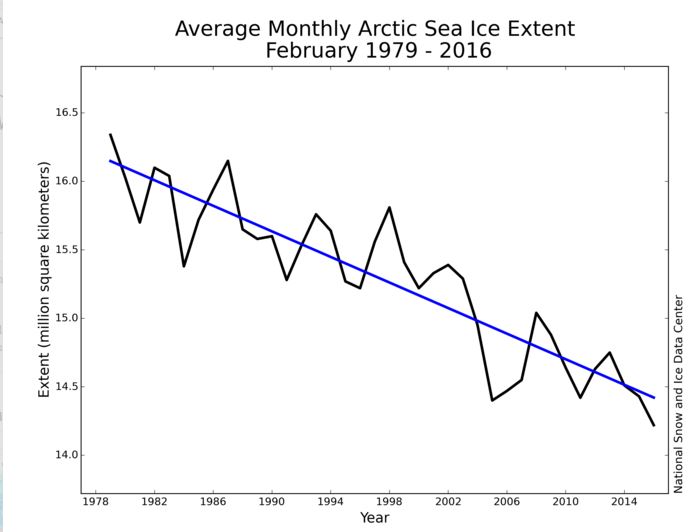| CLIMATE CHANGE Q & A |
| 1. There is some confusion between terms used in discussing climate change. What is the relationship between climate change, ozone depletion, and air pollution? |
| Ans. They are not directly related. Climate change is a change in the weather patterns (temperature, precipitation, etc.) over a long period of time. Ozone depletion refers to reductions in the ozone concentration in the high atmosphere due to specific compounds being released into the atmosphere that react with ozone molecules. Air pollution refers to the release into the atmosphere of particulates and contaminates that alter the makeup of the atmosphere, usually in a negative sense. |
| 2. Is the climate really changing? |
| Ans. The climate is changing on a global basis, in some regions more than others. NASA reports that the planet’s average surface temperature has risen about 1.0 degree Celsius since the late-19th century. Earth’s 2015 surface temperatures were the warmest since modern record keeping began in 1880, according to independent analyses by NASA and the National Oceanic and Atmospheric Administration (NOAA). You can watch a video here of earth temperatures since 1880. |
| 3. Not all scientists agree that the climate is changing. How do you account for the differences in scientific opinions? |
| Ans. Scientists can come to different interpretations depending on the methodology used, the biases implicit in the analysis. Science is an iterative process and over the years a strong consensus has developed that climate change is real and the dominant cause is our burning of fossil fuels. |
| 4. Is human activity responsible for the climate change we are seeing happen today? |
| Ans. Scientists from most countries of the world have studied the data and concluded the release of greenhouse gases (GHG's) into the atmosphere by human activity, mostly the burning of hydrocarbons, has caused much of the global warming we are observing.(IPCC Synthesis Report 2014) |
| 5. How do greenhouse gases cause global warming? |
| 6. Could there be other factors that are causing global warming, factors other than human activity? |
| Ans. Yes, it is possible that there are natural cycles impacting global warming. Variations in solar radiation, slight changes in the earth's axis, and volcanoes have been blamed for warm periods in pre-historic times. However, scientists do not see any of these factors at play currently in the warming trend being observed. |
| 7. Is a rise of a few degrees in global temperatures all that significant? |
| Ans. Yes. The difference between an ice-age and an interglacial is about 5 Deg. C. It is estimated that a doubling of GHG’s in the atmosphere would lead to a warming of 3 Deg. C. We have seen an increase of 1 Deg. C over the last 150 years. |
| 8. What are the major impacts of an increase in global temperatures? |
| Ans. Here are several: Melting glaciers and ice sheets will increase the height of the world's oceans, causing flooding in low-lying populated areas; vast areas of the world will receive insufficient rainfall to sustain populations; and other areas of the world will receive too much rain, or experience extreme weather that will result in catastrophic property damage and loss of life. |
| 9. How does melting a glacier increase the height of an ocean? That seems to be out of proprtion. |
| Ans. It may be surprising to many people, but presently, 10 percent of land area on Earth is covered with glacial ice, including glaciers, ice caps, and the ice sheets of Greenland and Antarctica. Glacierized areas cover over 15 million square kilometers. The ice sheets of Greenland and Antarctica store about 99 percent of the world's fresh water. As glaciers melt, they add water to the oceans, increasing their height. In addition, as oceans warm, they expand and increase their volume, adding to their height. (U.S. National Snow and Ice Data Center(NSIDC)). |
| 10. Who will be impacted most by a rising ocean? |
| Ans. If the earth experienced a sea level rise of 6 meters, about 150 million people would be affected. (Click here for more information). Most of them would be in China, India, Indonesia, and Bangladesh. By 2050, it is projected that 26 cities in the U.S. would be affected by flooding. |
| 11. It is often reported in the media that the latest record storm or flood is somehow related to climate change. Are extreme weather events more common, and are they due to climate change? |
| Ans. Statistics show that extreme weather events are becoming more common. Some of the increased impact is due to increased population density, construction in vulnerable areas, and greater detail in reporting. Statistics show that there are definitely increases in warm extremes and fewer cold extremes. Extreme precipitation events are more difficult to assess if they are linked to global warming. In a study of 8376 stations with 30 or more years of data, Francis Zweirs showed that the statistical liklihood of increased maximum one day preciptation events cannot be explained by random chance. (Francis Zweirs, PCIC, University of Victoria, CMOS 2016). Zweirs attributed the increased moisture of a warmer atmosphere as the likely cause of increased frequency and severity of precipitation events. Attributing any particular storm or trend at a specific location to climate change can not be scientifically proven at this point. In summary, changing the climate logically increases the chances of extreme events, as the climate moves to "new normals". |
| 12. Sometimes I hear political figures talk about "saving the planet". This makes a lot of people afraid. Is the planet really in danger? |
| Ans. It would be more accurate to say that most people on the planet will be impacted to some degree by climate change. In some cases, land occupied by millions of people will be flooded. Other areas will become more like a desert. Still others will be impacted by an increase in the frequency of extreme weather events. On a global scale, the poorest people are most vulnerable to extreme events. It is fair to say that the way of life for many will be disrupted, the disparity between the rich and poor will increase, and the geopolitical and economic consequences are unpredictable. |
| 13. The recent Paris conference saw an agreement by most of the world to limit greenhouse gas emissions. What specific actons might be taken, and more importantly, will it work? |
| Ans. The actions to be taken focus on reducing the production and release of carbon dioxide and other greenhouse gases into the atmosphere. The specific actions will vary with each country, but the general efforts will be to move away from burning fossil fuels to "cleaner" energy such as wind, solar, hydro-electric and nuclear energy. The goal is to limit the global temperature increase to 2 Deg. C or less from pre-industrial levels. Additional goals include finding ways to safeguard food production and to share the economic costs for adjustments and adaptation. For the agreement to work, each country will have to make a significant contribution and report regularly on progress. As there are no enforceable penalties, success will depend largely on goodwill. To read the Paris Agreement, visit here. |
| 14. Since Canada is part of the Paris Agreement, what will it cost Canadians to make our contribution? |
Ans. The costs will be substantial, spread over many years, with some costs offset by benefits. It is also important to recognize that not taking action could cost more than the cost of reducing emissions. For more background on the costs of action and inaction on climate change, please refer to an article in the journal Nature by Sir Nicholas Stern, February 25, 2016. As Canada is an exporting nation, it will be important to move in step with trading partners. It will also be important to be innovative in clean energy technology, with some potential industrial economic opportunities. In some cases, the costs are more about changing lifestyles to be more energy efficient and choosing alternate energy sources. This is where everyone can play a part.
|




